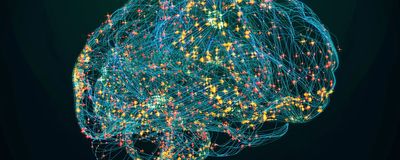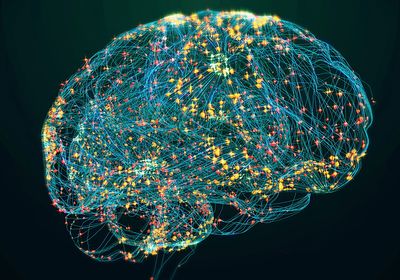ABOVE: Scientists are exploring the relationship between the expression of ancient viral DNA and neurodegenerative disease risk. ©iStock, nopparit
Of the approximately three billion bases of DNA that make up the human genome, a surprisingly large fraction are of non-human origin: About eight percent is composed of sequences from ancient retroviruses.1 These remnants are derived from infections that occurred millions of years ago and have been passed down through the germline ever since. Known as human endogenous retroviruses, or HERVs, these sequences no longer produce active viruses, and were once largely considered to be junk, said Timothy Powell, a neuroscientist at King’s College London. “[But] now, we're coming to understand that HERVs have quite a varied role,” said Powell. Some HERVs are translated into proteins that interact with the immune system, and others are transcribed into RNA molecules that may regulate the expression of other genes in complex and poorly understood ways; the roles of these genomic relics in health and disease remain largely unknown.2,3
In a recent study published in Brain, Behavior, and Immunity, Powell and his colleagues identified two specific HERV expression signatures associated with disease: downregulation of HERVs located on chromosome one and chromosome 12 were linked to increased susceptibility to multiple sclerosis (MS) and amyotrophic lateral sclerosis (ALS), respectively.4 This line of research could provide new insights into the processes driving these diseases and potentially reveal novel therapeutic targets.
Using data from previously published genome-wide association studies, the researchers assembled a catalogue of single-nucleotide polymorphisms (SNPs) associated with MS, ALS, Alzheimer's disease, and Parkinson’s disease. Next, they went hunting for these SNPs in a separate dataset from the CommonMind Consortium, which contains genomic and transcriptomic analyses of brain tissues from hundreds of individuals. “This allows us to infer how genetic risk factors—let's say for ALS—impact the expression of HERVs,” explained Powell.
After running multiple statistical tests, neither Alzheimer’s disease- nor Parkinson’s disease-associated genetic variants robustly affected HERV expression. However, MS genetic variants were robustly associated with decreased expression of a HERV called ERVLE_1p36.32a, and ALS variants were associated with decreased MER61_12q14.2 expression.
“It looks like the downregulation of the HERV is implicated in susceptibility, which means that the upregulation of the HERV [could be] involved in protection,” said coauthor Rodrigo Duarte, a research fellow in Powell’s group at King’s College London. “So, what does this mean? For me, this could mean that some of these viral genes evolved to play really important roles in the way our brain functions.”
This idea is not as far-fetched as it may initially appear: Several studies have already indicated that mammals can co-opt endogenous retroviruses to serve adaptive functions, including placenta formation and the regulation of gene expression during pregnancy.5,6
At present, the functions of the MS- and ALS-associated HERVs remain unknown, although analyzing their co-expression with other genes suggested involvement in processes related to homophilic cell adhesion, in which a cell surface molecule binds to the same type of molecule on another cell.
Christopher Power, who studies viruses and the nervous system at the University of Alberta and was not involved in the research, described the study as an impressive bioinformatics approach to exploring associations between HERVs and various neurodegenerative diseases. However, he noted that the study leaves many mechanistic questions unanswered. For example, he observed that the function inferred through the coexpression analysis—homophilic cell adhesion—is quite vague and therefore may provide limited insight into disease processes. Power said that future experiments will be necessary to validate the associations observed in this study.
“Overall, it's an important paper,” he said. “But it seems like there are a few questions that remain unclear. I think this is a further impetus to chase down the role of HERVs.”
Powell and Duarte agreed that there is, at present, relatively little scientific understanding of what most HERVs do, but they are eager to dive into these mysteries.
“If we can use this [approach] to pinpoint HERVs that are risk factors for different disorders or diseases, [then we can study] what are these HERVs doing,” said Powell. “We want to look at a more granular level as well—we know that they're expressed in the brain, but what cell types are important? How does manipulating these HERVs affect the development or the aging of neurons or glial cells, or whatever cells might be affected? Thinking about function is really the next priority.”
- Tokuyama M, et al. ERVmap analysis reveals genome-wide transcription of human endogenous retroviruses. Proc Natl Acad Sci U S A. 2018;115(50):12565-12572.
- Grandi N, Tramontano E. HERV envelope proteins: Physiological role and pathogenic potential in cancer and autoimmunity. Front Microbiol. 2018;9:462.
- She J, et al. The landscape of hervRNAs transcribed from human endogenous retroviruses across human body sites. Genome Biol. 2022;23(1):231.
- Duarte RRR, et al. Ancient viral DNA in the human genome linked to neurodegenerative diseases. Brain Behav Immun. 2025;123:765-770.
- Haig D. Retroviruses and the placenta. Curr Biol. 2012;22(15):R609-R613.
- Chuong EB. The placenta goes viral: Retroviruses control gene expression in pregnancy. PLOS Biol. 2018;16(10):e3000028.




